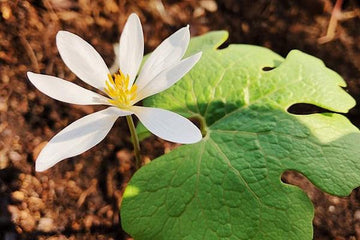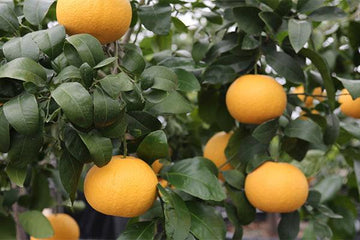How to Grow Bloodroot Flower (Sanguinaria canadensis), explained

by Jennifer Poindexter
Don’t you love planting flowers around your home that make you smile every time you look at them? Bloodroot is one of these flowers.
This plant has traditional white flowers with a yellow center. It makes it a great choice for brightening up a dull space or for adding a little cheer to your landscape.
If you could use a flower around your home that brings a little cheer to the situation, bloodroot could be for you.
Don’t worry if you’re unfamiliar with this plant. I’m going to walk you through what you should know to grow this flower successfully.
Here’s everything you must know when growing bloodroot.
GROWING CONDITIONS FOR BLOODROOT
Bloodroot is a unique plant. It doesn’t require a lot of extra work, but it may seem like it for the short display this flower provides.
In general, this plant may only bloom for a day or two. On cloudy days, the blooms will close early. They also close at night.
However, this plant also consists of curling foliage that remains on display most of the year. Keep in mind, bloodroot also spreads to form colonies. If you’re still interested in growing this plant, know that it’s a perennial in most locations.
In fact, bloodroot tends to thrive in planting zones three through eight. It also reaches a height of approximately one foot and can spread equally as wide around.
The perfect growing location for this plant consists of well-draining soil and partial sunlight. It does require enough light to encourage blooming.
Yet, it shouldn’t be in full sun as this will dry the plant out. It’s vital that the soil around the plant remain consistently damp without being soggy as this can cause issues.
If you supply all the right elements for bloodroot, it should bloom in early spring. Now that you know what this plant needs in a growing location, let’s discuss how to grow it.
HOW TO PLANT BLOODROOT
There are multiple ways to grow bloodroot. The first method is from a rhizome. It’s recommended to amend the soil of the planting location prior to planting bloodroot.
Once the soil is amended and loosely tilled, plant three rhizomes per row. Each should have one foot of space between them.
Plant the rhizome one inch beneath the soil surface and do so horizontally. Once the rhizomes are in place, lightly cover them with soil.
The next method to planting bloodroot is from seed. You can either purchase seeds or collect them from a mature bloodroot plant that has gone to seed.
This happens each growing season when the plant produces a seed pod. Instead of letting it reseed on its own, you can collect the pod and plant where you’d like the bloodroot to grow.
If growing seeds directly from the pod, replant them at the time of collecting the pod. Sow them in loose, well-draining soil. Then cover them lightly. They should germinate the following spring.
When growing bloodroot from purchased seeds, grow them in protected beds or deeper containers. Fill the beds or containers with well-draining soil and lightly sow the seeds. Water them lightly until they’ve germinated.
From there, continue to care for the bloodroot seedlings by providing water and indirect lighting. Over time, the plants will form their own rhizomes.
When this occurs, you’re ready to transplant the bloodroot flowers into their permanent growing location.
The final way to grow bloodroot is by division. If you have an established bloodroot plant, dig it up. Divide the plant with a trowel. Ensure each division has part of the root system intact.
Plant each division in an appropriate growing location which consists of the conditions previously mentioned.
There are many ways to go about growing bloodroot. Use the method that works best for you when adding bloodroot to your landscape.
CARING FOR BLOODROOT
Now that you know what bloodroot needs in a growing location and how to plant it, let’s discuss caring for the flower as it matures.
The only things this plant needs from you is water and mulch. However, before we get too far into caring for bloodroot, I need to issue a word of caution.
Bloodroot is a poisonous plant. Therefore, you must be mindful of pets and small children when growing it.
Also, use gloves when handling bloodroot. It contains a red sap, which also has to do with the plant’s name. Unfortunately, the sap can irritate your skin.
Now that you know how to safely handle the plant, let’s learn how to water it. Bloodroot needs consistently damp soil surrounding it.
Therefore, it’s best to deep water the plant. The deep watering method consists of watering the plant for longer periods of time, fewer days of the week.
In doing this, you’re ensuring water reaches the root of the plant at the time of watering. Yet, it also saturates the ground surrounding the bloodroot.
As the days progress, the plant will dig deeper into the soil to retrieve more water. This will help the plant form a deeper root system which typically equates to a healthier plant.
You’ll know it’s time to add more water by testing the soil. Insert your finger into the dirt next to the plant. When it’s dry to your first knuckle, deeply water the plant again.
If not, wait a day or two to test the soil again. You’ll need to water the plant less if it’s growing in a partially shaded location as it will take longer to absorb the water.
Keep in mind, the longer you water the plant, the longer it will remain active. Though it doesn’t bloom for a long period of time, the plant still produces a show of foliage.
Therefore, you should stop watering bloodroot in the fall and winter to provide a period of dormancy for its leaves.
The only other thing you must do to care for bloodroot is mulch. Lightly mulch after planting as this will keep the ground moist and cool.
You should mulch the plant again when you stop watering. The mulch will help protect the plant over the winter months. Be sure to use a leaf mulch as this is lighter and will allow the plant room to breathe.
This is all bloodroot needs from you while it’s growing. By watering and mulching the plant, it should have what it needs to thrive in your care.
GARDEN PESTS AND DISEASES WHICH IMPACT BLOODROOT
When growing bloodroot, you must understand how to protect your plants from pests and diseases which could cause harm.
The only pest which commonly impacts bloodroot is a slug. This pest typically comes out at dusk. Therefore, you can handpick them to remove them from your plant.
If there are too many, or you aren’t comfortable with this, place coffee grounds and diatomaceous earth beneath the plant.
The caffeine is a deterrent of slugs, and the diatomaceous earth creates a dangerous terrain for the pests to crawl over.
The main disease issues bloodroot faces are fungal. In order to stay ahead of these diseases, ensure the plants are spaced adequately to leave room for the ground to breathe. This will allow for better airflow and ensure the foliage stays dry.
You should also plant bloodroot in well-draining soil and where the plant will receive some sunlight. This will avoid the plant from growing in cold, wet soil as this is the perfect breeding ground for fungal diseases.
Follow these tips provided and hopefully they’ll help you avoid these issues. Be mindful of these threats to increase your chances of catching any potential problems early.
You now know how to provide an adequate growing space for bloodroot, how to plant it, how to care for it, and even how to protect it.
Growing anything new can feel like quite the adventure around the garden. However, with these helpful tips you should be well equipped for the journey.



